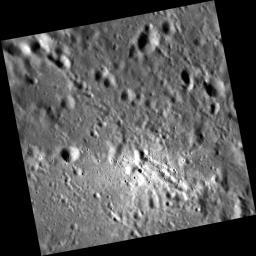The Details of a Ray
Caption:
What could have caused this small, bright swarm of impact craters? The fact that they are fairly similar in size and clustered together suggests that they are secondary craters, which form when material from a larger primary crater is ejected and impacts the surrounding terrain. The high albedo and sharp rims and walls of these small craters also suggest they formed relatively recently, though no large fresh craters are seen in the immediate surroundings. Instead, they appear to originate from
Fonteyn crater
, just over 1,000 km (622 mi.) to the east. This small, bright patch is a segment of one of Fonteyn's
beautiful rays
, and shows just how important a process secondary cratering is on Mercury, such that even craters around 29 km (18 mi.) in diameter can affect the surface great distances away.
This image was acquired as a high-resolution targeted observation. Targeted observations are images of a small area on Mercury's surface at resolutions much higher than the 200-meter/pixel morphology base map. It is not possible to cover all of Mercury's surface at this high resolution, but typically several areas of high scientific interest are imaged in this mode each week.
Date acquired:
August 30, 2012
Image Mission Elapsed Time (MET):
254798310
Image ID:
2485907
Instrument:
Narrow Angle Camera (NAC) of the Mercury Dual Imaging System (MDIS)
Center Latitude:
28.45°
Center Longitude:
67.70° E
Resolution:
34 meters/pixel
Scale:
This image is approximately 35 km (22 mi.) across
Incidence Angle:
69.9°
Emission Angle:
2.7°
Phase Angle:
72.5°
Background Info:
The MESSENGER spacecraft is the first ever to orbit the planet Mercury, and the spacecraft's
seven scientific instruments and radio science investigation
are unraveling the history and evolution of the Solar System's innermost planet. Visit the
Why Mercury?
section of this website to learn more about the key science questions that the MESSENGER mission is addressing. During the one-year primary mission, MDIS acquired 88,746 images and extensive other data sets. MESSENGER is now in a year-long extended mission, during which plans call for the acquisition of more than 80,000 additional images to support MESSENGER's science goals.
These images are from MESSENGER, a NASA Discovery mission to conduct the first orbital study of the innermost planet, Mercury. For information regarding the use of images, see the MESSENGER
image use policy
.
Cataloging Keywords:
| Name |
Value |
Additional Values |
| Target |
Mercury |
|
| System |
|
|
| Target Type |
Planet |
|
| Mission |
MESSENGER |
|
| Instrument Host |
MESSENGER |
|
| Host Type |
Orbiter |
|
| Instrument |
Mercury Dual Imaging System (MDIS) |
|
| Detector |
Narrow Angle Camera (NAC) |
|
| Extra Keywords |
Crater, Grayscale, Impact, Map, Radio |
| Acquisition Date |
|
| Release Date |
2012-10-17 |
| Date in Caption |
2012-08-30 |
|
| Image Credit |
NASA/Johns Hopkins University Applied Physics Laboratory/Carnegie Institution of Washington |
| Source |
photojournal.jpl.nasa.gov/catalog/PIA16427 |
| Identifier |
PIA16427 |

 Planetary Data System
Planetary Data System
